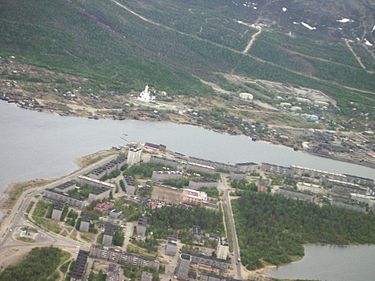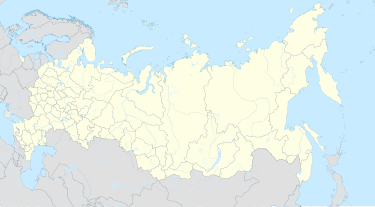Monchegorsk
Monchegorsk
Мончегорск | |
|---|---|
 Aerial view of Monchegorsk | |
| Coordinates: 67°56′N 32°55′E / 67.933°N 32.917°E | |
| Country | Russia |
| Federal subject | Murmansk Oblast[1] |
| Founded | 1930s |
| Town status since | September 20, 1937[2] |
| Government | |
| • Mayor | Dmitry Staroverov |
| Elevation | 130 m (430 ft) |
| Population | |
• Total | 45,361 |
| • Rank | 351st in 2010 |
| • Subordinated to | Monchegorsk Town with Jurisdictional Territory[1] |
| • Capital of | Monchegorsk Town with Jurisdictional Territory[1] |
| • Urban okrug | Monchegorsk Urban Okrug[4] |
| • Capital of | Monchegorsk Urban Okrug[4] |
| Time zone | UTC+3 (MSK |
| Postal code(s)[6] | 184505 |
| Dialing code(s) | +7 815 36 |
| OKTMO ID | 47715000001 |
| Website | www |
Monchegorsk (Russian: Мончего́рск) is a town in Murmansk Oblast, Russia, located on the Kola Peninsula, 145 kilometers (90 mi) south of Murmansk, the administrative center of the oblast. Population: 45,361 (2010 Census);[3] 52,242 (2002 Census);[8] 68,652 (1989 Census).[9]
Name
[edit]The name of the town derives from Akkala Sámi word monče 'beautiful'.[10] The name originally was intended for nearby Montshatuntur (Arctic Hill).[citation needed]
History
[edit]It was established in the 1930s[citation needed] as the inhabited locality of Moncha-Guba (Монча-Губа), which served copper and nickel mining in the Monchetundra Massif.[7] It was granted work settlement status and renamed Monchegorsk by the Resolution of the Presidium of All-Russian Central Executive Committee (VTsIK) on November 25, 1935.[7] At the same time, it was transferred from Kolsky District to Kirovsky District.[7] By 1937, the copper-nickel mining volume increased significantly, and, consequently, the area population grew as well.[2] On February 19, 1937, the Presidium of the Murmansk Okrug Executive Committee petitioned to create new Monchegorsky District by separating the town and its surrounding area from Kirovsky District and to grant Monchegorsk town status.[2] As a result, town status was granted to Monchegorsk by the VTsIK Resolution of September 20, 1937, although no new district was formed.[2] On October 10, 1937, Monchegorsk town council was subordinated directly to the Murmansk Okrug Executive Committee.[2]
On December 21, 1937, the Presidium of the Murmansk Okrug Executive Committee again petitioned to create a new district with the administrative center in Monchegorsk.[2] In a letter to the Leningrad Oblast Executive Committee and the VTsIK, the Presidium noted that Kirovsky District has two developed but unrelated industrial centers—Kirovsk and Monchegorsk—with the latter having a larger population and being located 111 kilometers (69 mi) away from the former.[2] The petition was again unsuccessful—when on February 10, 1938 the VTsIK adopted a new Resolution changing the administrative-territorial structure of Leningrad Oblast (of which Murmansk Okrug was a part), Monchegorsk remained a part of Kirovsky District.[2]
Monchegorsky District was eventually formed on December 27, 1938.[2] It existed until December 9, 1949, when by the Decree of the Presidium of the Supreme Soviet of the Soviet Union Monchegorsk was elevated in status to that of a town under oblast jurisdiction, with the former district's territory passing into its subordination.[2]
By the August 10, 1981 Presidium of the Supreme Soviet of the Russian SFSR Decree, the town of Olenegorsk was elevated in status to that of a town under oblast jurisdiction and subsequently several inhabited localities previously subordinated to Monchegorsk were transferred to Olenegorsk by the August 26, 1981 Decision of the Murmansk Oblast Executive Committee.[11]
Administrative and municipal status
[edit]Within the framework of administrative divisions, it is, together with three rural localities, incorporated as Monchegorsk Town with Jurisdictional Territory—an administrative unit with the status equal to that of the districts.[1] As a municipal division, Monchegorsk Town with Jurisdictional Territory is incorporated as Monchegorsk Urban Okrug.[4]
Economy
[edit]
Monchegorsk is a center of nickel cobalt and copper production (a Norilsk Nickel plant is located here). It also hosts the Monchegorsk air base of the Russian Air Force. The area surrounding the town is severely polluted. The Barents Euro-Arctic Council has listed Monchegorsk among the Barents Euro-Arctic region's environmental hotspots, though it noted that the problem was gradually being solved.[12] Since 1998, SO2 emissions in the Monchegorsk area have dropped by almost 60%, from 88.3 thousand tonnes to 37.3 thousand tonnes in 2016, according to Norilsk Nickel.[13] The company launched a $20 billion environmental programme aimed at reducing emissions, modernising and closing down polluting facilities, as well as implement energy saving and lower energy consuming measures.[14]
Demographics
[edit]| Year | Pop. | ±% |
|---|---|---|
| 1939 | 28,450 | — |
| 1959 | 45,523 | +60.0% |
| 1970 | 45,980 | +1.0% |
| 1979 | 51,401 | +11.8% |
| 1989 | 68,652 | +33.6% |
| 2002 | 52,242 | −23.9% |
| 2010 | 45,361 | −13.2% |
| 2021 | 39,962 | −11.9% |
| Population size may be affected by changes in administrative divisions. Source: Censuses[15][16][17][18] | ||
Ethnic composition (2010):[19]
- Russians – 91.1%
- Ukrainians – 3.0%
- Belarusians – 1.5%
- Azerbaijanis – 1.1%
- Tatars – 0.6%
- Others – 2.8%
Sports
[edit]The bandy team Kolskaya GMK has played in the highest division of Russian Bandy League, last in 2010–2011. Their home arena has a capacity of 5000.[1] Since 2009 there is also a female team.[2]
Notable people
[edit]- Alexander Kaletski, Russian-American artist
External links
[edit]References
[edit]Notes
[edit]- ^ a b c d e Law #96-01-ZMO
- ^ a b c d e f g h i j Administrative-Territorial Division of Murmansk Oblast, pp. 51–54
- ^ a b Russian Federal State Statistics Service (2011). Всероссийская перепись населения 2010 года. Том 1 [2010 All-Russian Population Census, vol. 1]. Всероссийская перепись населения 2010 года [2010 All-Russia Population Census] (in Russian). Federal State Statistics Service.
- ^ a b c Law #536-01-ZMO
- ^ "Об исчислении времени". Официальный интернет-портал правовой информации (in Russian). June 3, 2011. Retrieved January 19, 2019.
- ^ Russian Post. Postal Code
- ^ a b c d Administrative-Territorial Division of Murmansk Oblast, p. 49
- ^ Federal State Statistics Service (May 21, 2004). Численность населения России, субъектов Российской Федерации в составе федеральных округов, районов, городских поселений, сельских населённых пунктов – районных центров и сельских населённых пунктов с населением 3 тысячи и более человек [Population of Russia, Its Federal Districts, Federal Subjects, Districts, Urban Localities, Rural Localities—Administrative Centers, and Rural Localities with Population of Over 3,000] (XLS). Всероссийская перепись населения 2002 года [All-Russia Population Census of 2002] (in Russian).
- ^ Всесоюзная перепись населения 1989 г. Численность наличного населения союзных и автономных республик, автономных областей и округов, краёв, областей, районов, городских поселений и сёл-райцентров [All Union Population Census of 1989: Present Population of Union and Autonomous Republics, Autonomous Oblasts and Okrugs, Krais, Oblasts, Districts, Urban Settlements, and Villages Serving as District Administrative Centers]. Всесоюзная перепись населения 1989 года [All-Union Population Census of 1989] (in Russian). Институт демографии Национального исследовательского университета: Высшая школа экономики [Institute of Demography at the National Research University: Higher School of Economics]. 1989 – via Demoscope Weekly.
- ^ Мельхеев, М. Н. (1961). Географические имена: топономический словарь. Пособие для учителей. Москва: Гос. учебно-педагог. изд-во. p. 60.
- ^ Administrative-Territorial Division of Murmansk Oblast, p. 57
- ^ "Hot spots by Region - Barents Environmental Hot Spot Information System". www.barentsinfo.fi. Retrieved March 5, 2018.
- ^ "Strategy". Nornickel. Retrieved March 5, 2018.
- ^ "Mining companies spending millions to help boost the "green" economy - Analyses - EBR".
- ^ "(USSR) Urban population of the union republics, and their territorial units".
- ^ "Всероссийская перепись населения 2002 года. Том. 1, таблица 4. Численность населения России, федеральных округов, субъектов Российской Федерации, районов, городских поселений, сельских населённых пунктов - райцентров и сельских населённых пунктов с населением 3 тысячи и более". Archived from the original on February 3, 2012.
- ^ "Всероссийская перепись населения 2010 года. Итоги по Красноярскому краю. 1.10 Численность населения гор.округов, мун.районов, гор. и сел. поселе". Archived from the original on December 22, 2015.
- ^ "Таблица 5. Численность населения России, федеральных округов, субъектов Российской Федерации, городских округов, муниципальных районов, муниципальных округов, городских и сельских поселений, городских населенных пунктов, сельских населенных пунктов с населением 3000 человек и более - Итоги Всероссийской переписи населения 2021 года". Archived from the original on September 1, 2022. Retrieved October 1, 2021.
- ^ "Распределение населения Мурманской области по наиболее многочисленным национальностям по муниципальным образованиям". Archived from the original on March 3, 2016. Retrieved September 15, 2021.
Sources
[edit]- Мурманская областная Дума. Закон №96-01-ЗМО от 6 января 1998 г. «Об административно-территориальном устройстве Мурманской области», в ред. Закона №1953-01-ЗМО от 24 декабря 2015 г. «О внесении изменений в Закон Мурманской области "Об административно-территориальном устройстве Мурманской области"». Опубликован: "Мурманский Вестник", №10, стр. 3, 16 января 1998 г. (Murmansk Oblast Duma. Law #96-01-ZMO of January 6, 1998 On the Administrative-Territorial Structure of Murmansk Oblast, as amended by the Law #1953-01-ZMO of December 24, 2015 On Amending the Law of Murmansk Oblast "On the Administrative-Territorial Structure of Murmansk Oblast". ).
- Мурманская областная Дума. Закон №536-01-ЗМО от 2 декабря 2004 г. «О статусе муниципального образования город Мончегорск с подведомственной территорией», в ред. Закона №906-01-ЗМО от 26 октября 2007 г «О внесении изменений в некоторые законодательные акты Мурманской области в связи с упразднением населённых пунктов Мурманской области». Вступил в силу 1 января 2005 г. Опубликован: "Мурманский Вестник", №234, стр. 3, 7 декабря 2004 г. (Murmansk Oblast Duma. Law #536-01-ZMO of December 2, 2004 On the Status of the Municipal Formation of the Town of Monchegorsk with Jurisdictional Territory, as amended by the Law #906-01-ZMO of October 26, 2007 On Amending Various Legislative Acts of Murmansk Oblast Due to the Abolition of the Inhabited Localities in Murmansk Oblast. Effective as of January 1, 2005.).
- Архивный отдел Администрации Мурманской области. Государственный Архив Мурманской области. (1995). Административно-территориальное деление Мурманской области (1920-1993 гг.). Справочник. Мурманск: Мурманское издательско-полиграфическое предприятие "Север".




